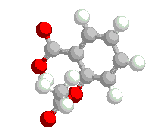| Fig.1. The five frames which make up an animated gif image (lower-right) of a Diels-Alder reaction, rendered in simple line drawing format. | ||
 |
 |
 |
 |
 |
 |
A gif (graphical interchange format) is a filetype used to display image information on the web. It has the advantage over other filetypes in that several gifs can be added together and then run sequentially to build up an animation. These will be familiar to most readers from the numerous irritating animated adverts which litter the web. Most graphical web browsers support animated gifs, and so they provide an easy way of getting animation onto a web page without having to rely on plug-ins or Java applets.
To create an animated gif, you first need a way of creating a normal gif. To do so, you'll need a graphics package, such as Paintshop Pro, CorelDraw, Lotus Freelance, Autocad or even Windows Paintbrush. The chosen package is used to draw, capture, or import the image, which is then saved in gif format. The image can be a line drawing, a diagram of a 3D molecular structure, or even a colour photograph. The image is then edited to make the next frame of the animation, and resaved with a different filename. This is repeated until all frames of the animation have been made and saved. Another package, such as Paintshop Pro-Animation Shop or Gif Construction Set can then be used to combine the set of frames into a single animated gif image. The delay between each frame can be set independently, as can options to loop the gif continually or only show it once. The individual frames and the animated gif files for three different chemical examples are given below.
| Fig.1. The five frames which make up an animated gif image (lower-right) of a Diels-Alder reaction, rendered in simple line drawing format. | ||
 |
 |
 |
 |
 |
 |
| Fig.2. A simple animated gif of an SN2 reaction made up of 7 individual frames. [sn2a.gif, sn2b.gif, sn2c.gif, sn2d.gif, sn2e.gif, sn2f.gif, sn2g.gif, sn2h.gif] |
 |
 |
Fig.3. A more complicated animated gif showing a rotating structure of the aspirin molecule. The gif is made up from 12 frames, each of which was created using snapshots from the 3D structure file displayed in Rasmol (see later). |